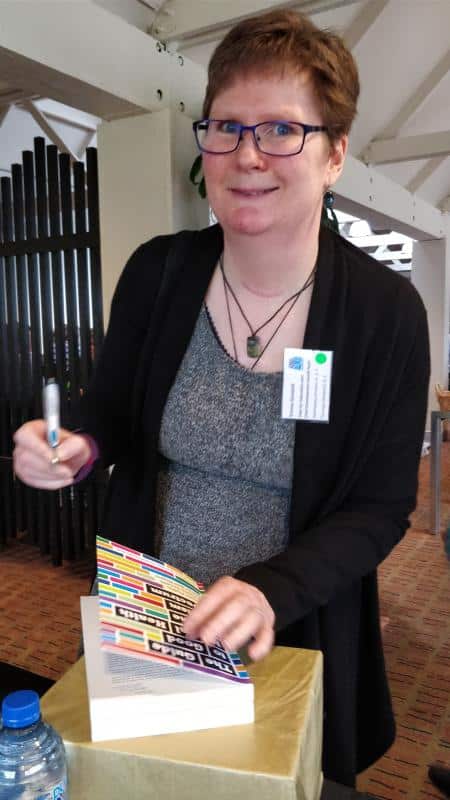
Emma Goodall
8 January 2018 – Emma Goodall is autistic, an educator and an autism adviser. She writes about how that means she questions everything.
I HAVE demonstrated my fair share of ‘challenging behaviours’ over the years.
Being who I am has led me to question everything, not the least of which is what we mean by challenging behaviour.
As a result, I initially came to the following definition:
“Challenging behaviours are those that hurt or damage self, others or things/the environment around.”
However, after being involved in two years of highly successful trials in schools and pre-schools in South Australia to reduce ‘challenging behaviour’, I have come to a different conclusion.
For many autistic children and students, behaviours that harm self/others/things present once the survival instinct of fight (or flight, or freeze or flop/drop) has kicked in.
Our survival instinct kicks in when our sympathetic nervous system signals to the brain that we are in imminent danger. The problem is that in autism, as with a range of other neurodiversities, our brain gets the signal wrong. So, for example, anxiety or frustration can be misread by our nervous system and then our brain as danger. This tips us over into survival mode and we enter our default state for us of either flight or freeze/hide/flop/drop or fight. If approached or interacted with in the first two states, this sends signals to the brain that the danger has increased and so we have to ‘fight’ in order to ensure we survive.

BOOK SIGNING: Emma Goodall at the recent Altogether Autism conference.
One of the reasons that neurodiverse brains get the signals so wrong is that many of us have an inaccurate and/or low level of interoceptive awareness. Interoception is the sense of our internal self, the signals from our body that indicate our state of being. For example; our temperature, our heart rate, breathing rate, muscle tension, body placement, thirst, hunger, pain etc. This awareness of sensation is governed by our insula in our brains. The way that humans experience emotions is that we become aware of our body state through our insula and then interpret the collection of body states, for example sore tense shoulders with pain across top of the skull in my case is interpreted as frustration. Emotions and feelings are signalled by at least two body signals. If you have a fluttery tummy, but can’t read/notice a second signal, it will be hard to identify if you are feeling sick, in love, nervous etc.
When people with good interoception start to feel frustrated or angry or upset, they know this and can do something about it. However, when people, including autistic students, have low levels of interoception or inaccurate interoception, they don’t know when they are beginning to feel an emotion as they do not notice the body signals. Often these are the students that seem fine and then, all of a sudden, ‘lose it’. Both meltdowns and shutdowns are examples of sympathetic nervous system overload, where the brain signals imminent danger and the survival instinct kicks in. At this point the student is unable to think, their behaviour is automatic.
Through the two years of trials in South Australia, we have confirmed what neuroscience, psychology and occupational therapists are saying: interoception is necessary in order to be able to self-regulate and that we can teach interoception in schools. Neuroplasticity is the concept of brains being able to change as they learn new skills. Through our use of regular interoception teaching (2-3 times a day for 1-5 mins each time), we have found that students, including those on the autism spectrum, develop a greater and more accurate sense of interoception. This directly correlates to lower levels of harm to self/others/things and an increase in pro-social behaviour, such as kindness.
An interoception activity is one that changes the state of the body and the student is guided to notice. So for example, warm up stretches become an interoception activity if the student is guided where they could feel their muscles change. Each person will feel the stretch slightly differently once they actually notice it. However, in the beginning, many neurodiverse students, along with students who have experienced trauma, do not feel anything.
Schools and pre-schools that implement our free interoception curriculum[i] all show significant decrease in behaviours that harm self/others/things within 8-10 weeks. This decrease varies from 30-85% depending on how often teachers pre-empt behaviours by utilising interoception activities. So, for example, in classrooms where teachers encourage individuals to engage in interoception activities as soon as they notice that students are off task, within a term ‘challenging behaviour’ is rarely seen. Another way of implementing the interoception approach to managing behaviour is to start the day with 20 mins of interoception. In classes, including at special school, where this has been done, students have been able to be co-regulated or able to self-regulate for the rest of the day within 6-8 weeks.
When children can’t read we teach them, when they can’t write, we teach them. In the interoception approach, when children can’t self-regulate we teach them the skills to help their insula work better, which enables them to become aware of their bodies and connect to the way they are feeling and so be able to manage this. All these steps are required in order to be able to self-regulate. Without giving students the opportunity to develop their interoception they will NEVER be able to consistently manage themselves. What this means in practical terms is that in the classroom students who often harm selves/others/things or withdraw frequently, need to develop better interoception.
This approach is not an instant fix, it is however a highly effective long-term strategy. To be most effective it requires a shift in understanding of ‘challenging behaviour’ to one that distinguishes deliberate behaviour from survival instinct behaviour and where that distinction is too difficult errs on the side of it being survival instinct. This means that when a child exhibits these behaviours that teachers understand that approaching the child WILL escalate things. Pre-empting behaviour becomes the key strategy, through use of whole class regular interoception activities which we have repeatedly shown decrease the sympathetic nervous system activity in students (i.e. calms them down on a bio-chemical level). Once students become aware that interoception activities help them to ‘feel’ and to ‘feel better’, they can be prompted to do these at regular intervals throughout the day.
Autistic students have reported that after one or two terms of daily interoception they are now able to self-regulate and manage life much better. Additional activities to support areas of interoception that we cannot teach such as thirst and bowel health have also been shown to positively impact on classroom behaviours. A hydration chart is used to enable students to know when they are optimally hydrated to seriously dehydrated. Our data indicates that students who are dehydrated exhibit far more behaviours of harm to self/others/things. Data from across pre-school to high-school has shown that the use of hydration (or urine) charts improves focus and engagement in learning whilst decreasing behaviours of harm. Teaching around the hydration chart involves a discussion about what colour (clear) and smell (none) urine should have if we are optimally hydrated and why we need to be hydrated (our brains require water to work properly). Hydration/urine charts can be placed on the back of toilet doors and students encouraged to drink when needed. Most students love this simple strategy to improve their wellbeing and want to ensure their family members are also optimally hydrated! Our pre-schools and special schools have found that their children are able to self-manage drinking after a short time and this results in massive improvements in behaviour and engagement in learning.
We also use Bristol stool charts to empower children and young people to take control of their bowel health. This is because we had data from our Centre for Disability Health that indicated that the number one cause of challenging behaviour in students on the autism spectrum in South Australia was constipation. For those of you who have never had constipation, it is an incredibly painful, and dangerous condition. People, including children, can die from untreated constipation. However, for many autistic children (and adults), they do not know that they are experiencing pain and so do not seek help or treatment. Their brain however, is receiving the pain signals and this increases the sympathetic nervous system response. As it ramps up and the child, young person or adult is oblivious to this, they can’t and don’t do anything about it, which means it keeps ramping up until it overloads and results in the survival instinct kicking in. Teaching students about bowel health using the Bristol stool chart, we have been able to refer families to their GP to seek support to manage constipation. This has always resulted in decreasing and even eliminating behaviours of harm.
Families can use all these strategies at home for children of all ages, including parents themselves. I personally have improved my interoception through these activities and as a result am much better at self-regulating my emotions.[ii]
Dr Emma Goodall (PhD, MEd, Bed hons) is an autistic, educator, author and researcher. She is the senior autism adviser for the Department for Education and Child Development in South Australia.
Resources:
[i] http://web.seru.sa.edu.au/pdfs/Introception.pdf
[ii] https://mindfulbodyawareness.com/resources/
This article first appeared in the Altogether Autism Journal Issue 1, 2018.


